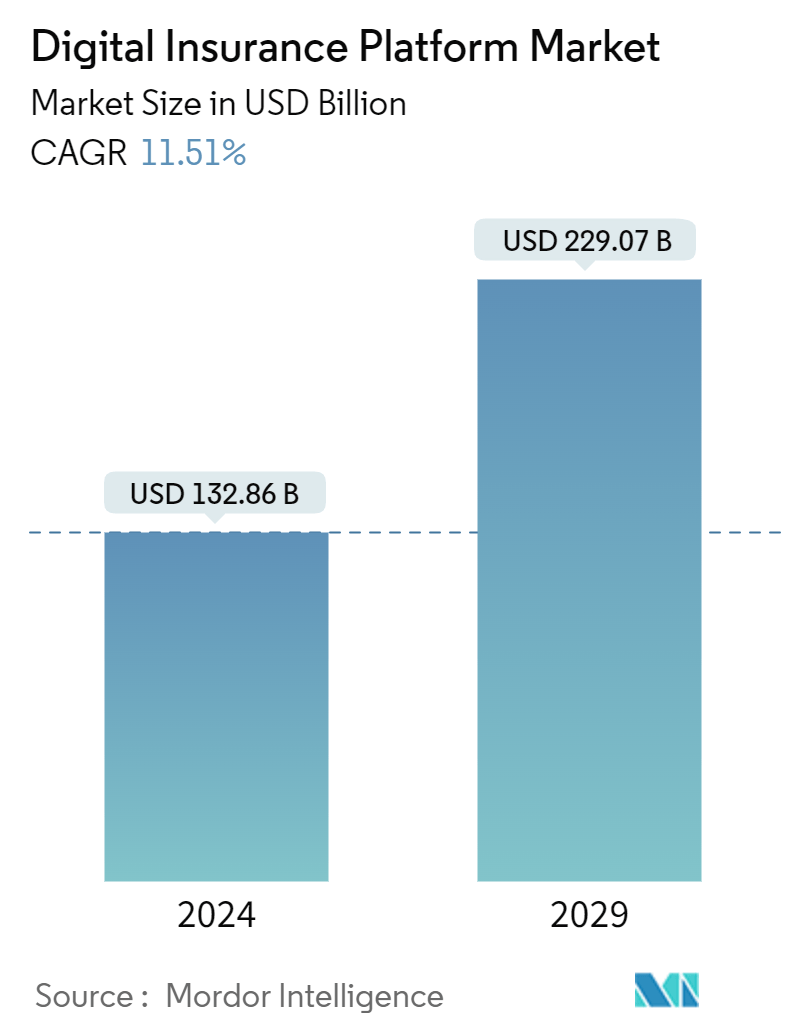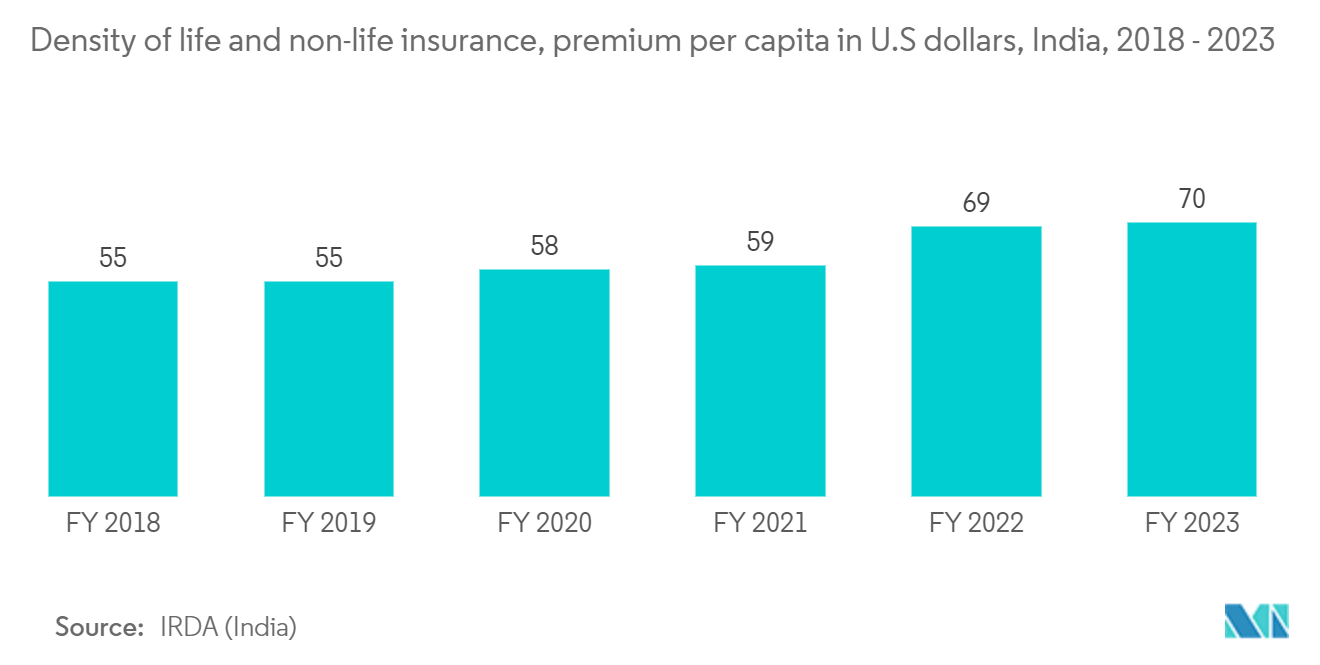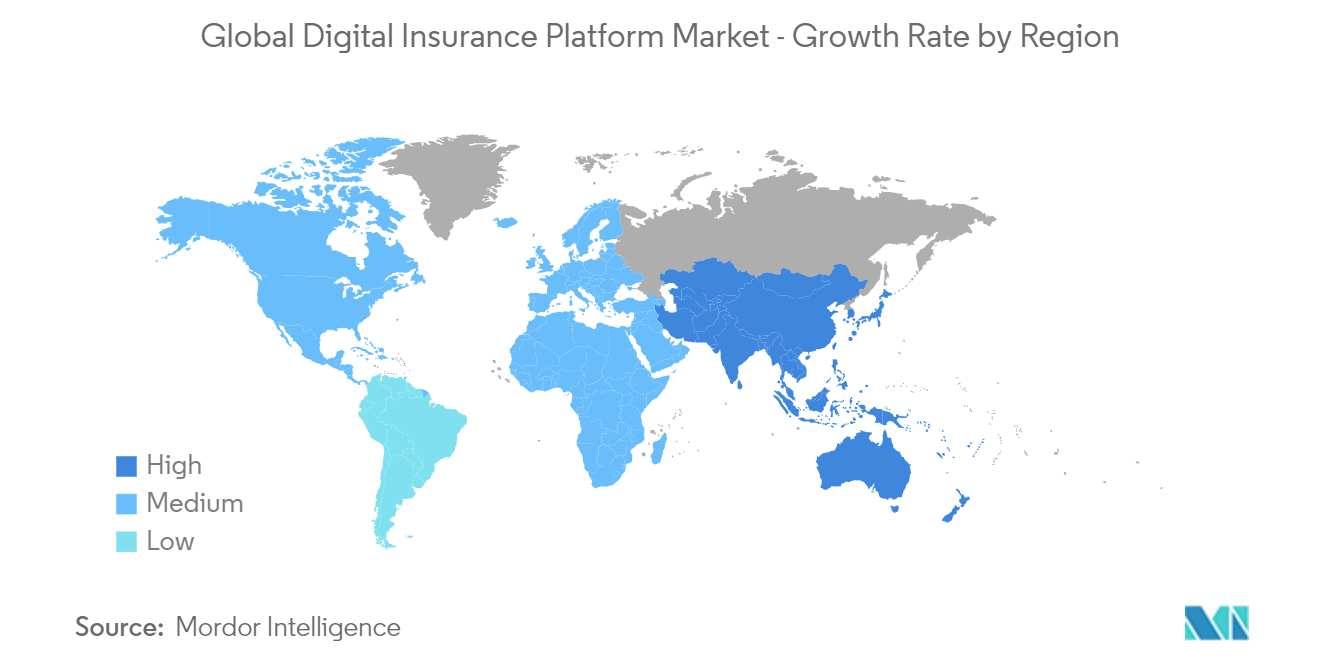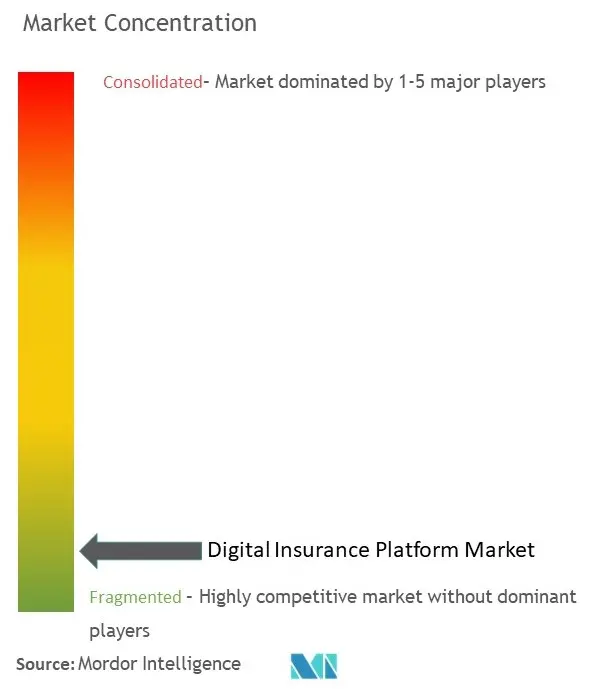Digital Insurance Platform Market Size

| Study Period | 2019 - 2029 |
| Market Size (2024) | USD 132.86 Billion |
| Market Size (2029) | USD 229.07 Billion |
| CAGR (2024 - 2029) | 11.51 % |
| Fastest Growing Market | North America |
| Largest Market | Asia Pacific |
Major Players
*Disclaimer: Major Players sorted in no particular order |
Digital Insurance Platform Market Analysis
The Digital Insurance Platform Market size is estimated at USD 132.86 billion in 2024, and is expected to reach USD 229.07 billion by 2029, growing at a CAGR of 11.51% during the forecast period (2024-2029).
Insurtech companies are disrupting the insurance industry by building digital platforms and collaborating with insurance companies and suppliers. The paradigm shift from a product-centric model in traditional insurance companies to a primarily client-centric model has been enabled by the digital insurance platforms enabled by technologies like IoT, Big data analytics, blockchain, artificial intelligence, and cloud computing.
- Customer loyalty and satisfaction have become primary concerns for insurance companies. Artificial intelligence (AI) and related technologies are expected to significantly impact all aspects of the insurance value chain, from distribution to underwriting and pricing to claims management. This may result in policies being priced, purchased, and bound in near real-time. Through these, insurers have been able to smartly connect information and quickly deliver innovative products and services, which, in the end, will significantly improve customer loyalty and satisfaction.
- Signs of massive and unprecedented progress are observed across the insurance industry. Explore new technologies and partner with insurance companies and their existing technology partners to develop new models and tools. Others stimulate their business results by executing quick minimum viable products (MVPs), proof of concepts (POCs), and straight into production.
- Many seek ways to speed up their existing digital roadmaps during and post-pandemics. And some are exploring new outsourcing solutions to drive agility. Over the past few months, the market has focused on digitizing the contact centers and the claims functions. Notably, significant progress was made in adopting automation and process streamlining, improving the use of structured and unstructured data, external data, and the exploratory use of knowledge.
- On the flip side, the shift to digital insurance has increased the volume of data required and the variety of methods for processing it. When updating its catastrophe models, an insurance company, for instance, needs to know how many houses and businesses are vulnerable to manage risk and adjust its writings accordingly. In the future, a more comprehensive range of threats will need to be covered by catastrophe modeling. Further, insurance firms, particularly those who sell cyber insurance, have a specific obligation to protect their systems and data against hacking to manage risk and maintain the trust of their insured. Insurance providers require the appropriate procedures to manage their insured's information securely.
- Cloud computing allows insurance companies to scale their operations up or down quickly in response to changing business needs. This scalability and flexibility are crucial in handling fluctuations in customer demand and adapting to market changes.
- Integrating digital insurance platforms with the lagacy system is a common challange in the insurance industry and can restrain the growth of the digital insurance platform market. Several difficulties and complexities associated with this integration can hinder the adoption and implementation of modern digital solutions.
Digital Insurance Platform Market Trends
Growing Cloud Adoption is Expected to Drive the Market Growth
- The increasing realization among enterprises about the importance of saving money and resources by moving their data to the cloud instead of building and maintaining new data storage is driving the demand for cloud-based solutions and hence, the adoption of on-demand digital insurance platforms in the region. Owing to multiple benefits, and over the course of the next few years, cloud platforms and ecosystems are anticipated to serve as a launchpad for an explosion in the pace and scale of digital innovation.
- Cloud-based insurance solutions can offer better social listening and higher conversion rates from opportunity to sale through targeted campaign management and improved opportunity and lead engagement models. This could result in higher upsell, cross-sell, and retention rates. Cloud can also enhance the claims experience by providing better service and better communication with end customers. This ability of the cloud is augmenting the growth of the cloud-based digital insurance platform market.
- Furthermore, deploying public cloud service extends the boundary of trust beyond the organization, making security a vital part of the cloud infrastructure. However, the increasing usage of cloud-based solutions has significantly simplified insurance firms' adoption of cybersecurity practices.With the increased adoption of cloud services, such as Google Drive, Dropbox, and Microsoft Azure, among others, and with these tools emerging as an integral part of business processes, enterprises must deal with security issues, such as loss of control over sensitive data. This gives rise to the increased incorporation of on-demand solutions.
- The increasing complexity of the healthcare IT landscape is driving healthcare organizations to look for alternate options that can support digital strategies and increase agility while reducing costs. For instance, last year, Red Hat announced that Medifé Asociación Civil, a non-profit healthcare insurance organization in Argentina, selected RedHat to implement a new digital application architecture based on Red Hat's open hybrid cloud technologies to support the changing remote healthcare services during a pandemic.
- Organizations with fluctuating bandwidth demand primarily need to scale up and down their capacity quickly. Cloud technology provides organizations with the flexibility they need to increase and decrease their bandwidth with the needs of their operation. This approach can cut costs and give businesses an edge over the competition.

Asia Pacific is Expected to Hold Significant Market Share
- The emergence of insurance ecosystems is only the beginning. The integration of payment and social media into platforms that enable targeted insurance marketing and offer highly responsive customer engagement capabilities is something that insurance companies see all over Asia. These platforms offer insurers payment and marketing services for the first time. As a result, those working in the tech industry can use their scale to provide insurance goods and services without duplicating some of the fees and expenses incurred by traditional insurance companies.
- According to IRDA(Insurance Regulatory and Development Authority), In India, there were 67 insurers in operation at the end of the last fiscal year. Out of these, five were independent health insurers, 27 were general insurers, and 24 were life insurers. 11 reinsurers, including branches of overseas reinsurers, were also present in the nation. Life Insurance Corporation (LIC) is the only company in the public sector that provides life insurance. In the non-life insurance business, there are six public sector insurers. In addition, the General Insurance Corporation of India is the only national reinsurer. Such a huge number of insurance firms will create an opportunity for the studied market to grow.
- Further, by 2029, Asia Pacific is estimated to account for 42% of global insurance premiums, with China's share forecast to be 20%, according to Swiss Re. The country is on course to become the largest insurance market by the mid-2030s. According to a report by Bain & Company, consumers in Asia-Pacific's developing markets are significantly underinsured, with one measure of insurance penetration, gross written premiums as a percentage of per-capita GDP, signaling a significant amount of unmet demand in Asia-Pacific's developing markets where penetration is less than 5% in India, mainland China, Indonesia, and Malaysia.
- The insurance distribution landscape is gradually evolving. In China, digital channels are becoming more prominent. In many Asia Pacific jurisdictions, consumers are open to having insurers provide ecosystem services. These digital insurance ecosystems are interconnected players forming sets of products and services that allow users to fulfill a variety of needs in one integrated experience. This is expected to augment the demand for a digital insurance platform.
- To meet the various demands of the customers and increase the market share, insurance firms in the region are investing in digitalization. For instance, this year, Warburg Pincus, a private equity (PE) firm, invested USD 350 million in equity to launch a digital general insurance platform in Southeast Asia. This is the business's largest investment in the region's insurance market.

Digital Insurance Platform Industry Overview
The Digital Insurance Platform is fragmented, with the presence of major players like IBM Corporation, Microsoft Corporation, Oracle Corporation, Pegasystems Inc., and Appian Corporation. Players in the market are adopting strategies such as partnerships and acquisitions to enhance their product offerings and gain sustainable competitive advantage.
- September 2023 - Majesco, one of the global leaders in cloud insurance software solutions, and Microsoft entered a strategic alliance to drive long-term digital transformation for insurers. The partnership empowers consumers with a scalable and secure intelligent cloud environment by leveraging Microsoft Cloud and Analytics capabilities.
- April 2023 - EY organization announced a partnership with the EIS Group Inc (EIS), one of the global digital insurance platform providers, and Ernst & Young LLP (EY US) to assist clients in executing and combining EIS' cloud-native and digital insurance platform, a primary application programming interface, to address challenges and future requirements in the insurance industry.
Digital Insurance Platform Market Leaders
-
IBM Corporation
-
Microsoft Corporation
-
Oracle Corporation
-
Pegasystems Inc.
-
Appian Corporation
*Disclaimer: Major Players sorted in no particular order

Digital Insurance Platform Market News
- August 2022 - USAA Life announced a partnership with Human API, a health data platform, to further digitize the life insurance buying process. USAA will get access to its members' digital health data using Human API's Health Intelligence Platform, which consists of a patient portal network and HIPAA-authorized networks, to enhance the user experience and streamline and speed up the purchasing process.
- April 2022 - To assist insurance businesses with their digital transformation, Mindtree, a provider of technology services, has teamed up with Sapiens International Corporation. This company develops software solutions for the banking and insurance sectors. Insurance firms will be able to boost scalability, speed-to-market, and customer happiness thanks to the partnership between Sapiens and Mindtree and their advanced, cloud-native core suite of banking and insurance apps.
Digital Insurance Platform Market Report - Table of Contents
1. INTRODUCTION
- 1.1 Study Assumptions and Market Definition
- 1.2 Scope of the Study
2. RESEARCH METHODOLOGY
3. EXECUTIVE SUMMARY
4. MARKET INSIGHTS
- 4.1 Market Overview
-
4.2 Industry Attractiveness - Porter's Five Forces Analysis
- 4.2.1 Threat of New Entrants
- 4.2.2 Bargaining Power of Buyers/Consumers
- 4.2.3 Bargaining Power of Suppliers
- 4.2.4 Threat of Substitute Products
- 4.2.5 Intensity of Competitive Rivalry
- 4.3 Assessment of COVID-19 impact on the industry
5. MARKET DYNAMICS
-
5.1 Market Drivers
- 5.1.1 Increasing Shift of Insurance Companies From Product Based to Customer-centric Strategies
- 5.1.2 Increased Awareness Among Insurers About Digital Channels
- 5.1.3 Growing Cloud Adoption
-
5.2 Market Restraints
- 5.2.1 Difficulty Regarding Integration of Insurance Platform with Legacy Systems
6. MARKET SEGMENTATION
-
6.1 By Deployment
- 6.1.1 Cloud
- 6.1.2 On-premise
-
6.2 By Organization Size
- 6.2.1 Large Enterprises
- 6.2.2 Small and Medium Enterprises
-
6.3 By Application
- 6.3.1 Automotive and Transportation
- 6.3.2 Home and Commercial Buildings
- 6.3.3 Life and Health
- 6.3.4 Business and Enterprise
- 6.3.5 Consumer Electronics and Industrial Machines
- 6.3.6 Travel
-
6.4 By Geography***
- 6.4.1 North America
- 6.4.1.1 United States
- 6.4.1.2 Canada
- 6.4.2 Europe
- 6.4.2.1 United Kingdom
- 6.4.2.2 Germany
- 6.4.2.3 France
- 6.4.3 Asia
- 6.4.3.1 China
- 6.4.3.2 Japan
- 6.4.3.3 India
- 6.4.3.4 Australia and New Zealand
- 6.4.4 Latin America
- 6.4.5 Middle East and Africa
7. COMPETITIVE LANDSCAPE
-
7.1 Company Profiles
- 7.1.1 IBM Corporation
- 7.1.2 Microsoft Corporation
- 7.1.3 Oracle Corporation
- 7.1.4 Pegasystems Inc.
- 7.1.5 Appian Corporation
- 7.1.6 Mindtree Ltd
- 7.1.7 DXC Technology Company
- 7.1.8 Prima Solutions SA
- 7.1.9 Majesco
- 7.1.10 EIS Software Limited
- *List Not Exhaustive
8. INVESTMENT ANALYSIS
9. MARKET OPPORTUNITIES AND FUTURE TRENDS
** Subject To AvailablityDigital Insurance Platform Industry Segmentation
Digital insurance platforms support insurers by enhancing the efficiency of central-core systems and the differentiation of easy-to-compose customer experience. The digital insurance platform providers' prime responsibility is to ensure the proper deployment and integration of digital insurance solutions as per the specific requirements of clients. By type of deployment, the market is divided into on-premise and cloud. The organization size segments include large enterprise and small and medium enterprises.
The digital insurance platform market is segmented by deployment (on-premise, cloud), by organization size (large enterprise, small & medium enterprise), by application (automotive and transportation, home & commercial buildings, life & health, business & enterprise, consumer electronics & industrial machines, travel), by geography (North America, Europe, Asia Pacific, Latin America, and Middle East and Africa). The market sizes and forecasts are provided in terms of value in USD for all the above segments.
| By Deployment | Cloud | |
| On-premise | ||
| By Organization Size | Large Enterprises | |
| Small and Medium Enterprises | ||
| By Application | Automotive and Transportation | |
| Home and Commercial Buildings | ||
| Life and Health | ||
| Business and Enterprise | ||
| Consumer Electronics and Industrial Machines | ||
| Travel | ||
| By Geography*** | North America | United States |
| Canada | ||
| By Geography*** | Europe | United Kingdom |
| Germany | ||
| France | ||
| By Geography*** | Asia | China |
| Japan | ||
| India | ||
| Australia and New Zealand | ||
| By Geography*** | Latin America | |
| Middle East and Africa |
Digital Insurance Platform Market Research FAQs
How big is the Digital Insurance Platform Market?
The Digital Insurance Platform Market size is expected to reach USD 132.86 billion in 2024 and grow at a CAGR of 11.51% to reach USD 229.07 billion by 2029.
What is the current Digital Insurance Platform Market size?
In 2024, the Digital Insurance Platform Market size is expected to reach USD 132.86 billion.
Who are the key players in Digital Insurance Platform Market?
IBM Corporation, Microsoft Corporation, Oracle Corporation, Pegasystems Inc. and Appian Corporation are the major companies operating in the Digital Insurance Platform Market.
Which is the fastest growing region in Digital Insurance Platform Market?
North America is estimated to grow at the highest CAGR over the forecast period (2024-2029).
Which region has the biggest share in Digital Insurance Platform Market?
In 2024, the Asia Pacific accounts for the largest market share in Digital Insurance Platform Market.
What years does this Digital Insurance Platform Market cover, and what was the market size in 2023?
In 2023, the Digital Insurance Platform Market size was estimated at USD 117.57 billion. The report covers the Digital Insurance Platform Market historical market size for years: 2019, 2020, 2021, 2022 and 2023. The report also forecasts the Digital Insurance Platform Market size for years: 2024, 2025, 2026, 2027, 2028 and 2029.
Digital Insurance Platform Industry Report
Statistics for the 2024 Digital Insurance Platform market share, size and revenue growth rate, created by Mordor Intelligence™ Industry Reports. Digital Insurance Platform analysis includes a market forecast outlook to 2029 and historical overview. Get a sample of this industry analysis as a free report PDF download.



